
Today is the winter solstice, the shortest day of the year with the least daylight. Due to Japan’s north-south expanse, daylight hours vary across the country. In Tokyo, the daylight duration on the winter solstice is 9 hours and 45 minutes, while on the summer solstice, it is 14 hours and 35 minutes – a difference of 4 hours and 50 minutes. In the northern city of Nemuro, situated at a higher latitude, the difference is 6 hours and 25 minutes, whereas in Malacca, located near the equator at approximately 2 degrees north latitude, the difference is only 15 minutes. These natural environmental variations likely contribute to regional and cultural differences.
By the way, the Antarctic region is currently experiencing continuous daylight during its summer. Surprisingly, today is the winter solstice, not the summer solstice. Although it may be a bit complex, solstices are defined in astronomy.
I saw scenes on TV of people throwing yuzu (citrus fruit) into hot bathwater, a traditional practice for this day. There seems to be a habit of eating Nanjing too. As we head into the heart of winter, knowing that daylight hours will gradually increase starting tomorrow brings a clear and uplifting feeling.
今日は冬至です。1年間で最も昼間の時間が短い日です。日本は南北に長いので昼間の時間は異なります。東京では、冬至の昼間の時間は9時間45分で、夏至の昼間の時間は14時間35分です。その差は4時間50分です。緯度の高い根室ではその差が6時間25分で、赤道にほど近い北緯2度に位置するマラッカでは、その差は15分しかありません。こうした自然環境の違いが、地域性、国民性の違いになって現れるんでしょうね。因みに、南極圏は今夏で、しばらくは24時間昼間です。そして今日は夏至かと思いきや、やはり冬至です。ちょっと難しいですが、夏至、冬至は天文学で定義されています。テレビでも、銭湯の湯船に柚子を投げ入れる場面が流れていましたが、南京を食べたる習慣もある様です。これからが本格的な冬になるのですが、明日から徐々に昼間の時間が長くなるのかと思えば、心まで晴れやかな気分になります。
